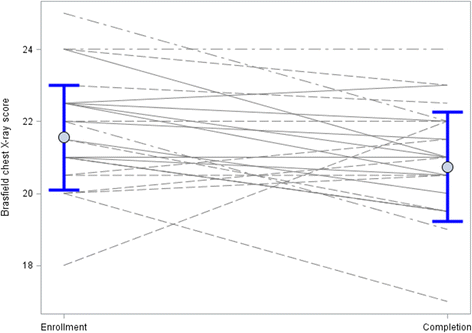Pulmonary exacerbations and clinical outcomes in a longitudinal cohort of infants and preschool children with cystic fibrosis
- PMID: 29228933
- PMCID: PMC5725640
- DOI: 10.1186/s12890-017-0546-8
Pulmonary exacerbations and clinical outcomes in a longitudinal cohort of infants and preschool children with cystic fibrosis
Abstract
Background: Pulmonary exacerbations (PEx) in school aged children and adults with cystic fibrosis (CF) lead to increased morbidity and lung function decline. However, the effect of exacerbations in young children with CF is not fully understood. We sought to characterize the frequency and clinical impact of PEx in a pilot study of infants and pre-school aged children with CF.
Methods: Thirty young children with CF [median (range) 1.5 years (0.2-4.9)] were prospectively followed for 2 years. Exacerbation frequency (hospitalizations and outpatient antibiotic use) was determined. Chest radiographs were performed at enrollment and study completion and assigned a Brasfield score. Lung function at age 7 years was assessed in a subset of children. The association between PEx frequency, chest radiograph score, and lung function was determined using Spearman correlation coefficients and corresponding 95% confidence intervals. Correlations with an absolute magnitude of 0.3 or greater were considered clinically significant.
Results: Over 2 years, participants experienced a median of two PEx (range 0-13). Chest radiograph scores at enrollment and study completion were inversely associated with PEx frequency (R = -0.48 and R = -0.44, respectively). The association between frequency of PEx and lung function [forced expiratory volume in 1 s (FEV1)] at age 7 years was small (R = 0.20). Higher forced vital capacity (FVC) at 7 years was associated with more frequent PEx during the study (R = 0.44).
Conclusions: Children with worse chest radiograph scores had more frequent PEx over the subsequent 2 years, suggesting a group of patients at higher risk for PEx. Frequent PEx in infants and young children with CF were not associated with lower FEV1 and FVC at 7 years, although spirometry in this age group may not be a sensitive marker of mild lung disease and disease progression.
Keywords: Antibiotics; Cystic fibrosis; Lung function; Pulmonary exacerbation.
Conflict of interest statement
Ethics approval and consent to participate
The Colorado Multiple Institutional Review Board approved the study (COMIRB #: 07–0839). Written informed consent was obtained for all patients. Consent to participate for all subjects under 16 years old was given by a parent or legal guardian. HIPAA standards were maintained during the study.
Consent for publication
Not applicable
Competing interests
Dr. Zemanick reports grants from Cystic Fibrosis Foundation, during the conduct of the study and grants from NIH/ NHLBI, grants from Cystic Fibrosis Foundation outside the submitted work. Dr. Hoppe reports grants from Cystic Fibrosis Foundation, during the conduct of the study, outside the submitted work. Dr. Sagel reports grants from National Institutes of Health, grants from Cystic Fibrosis Foundation, outside the submitted work. Dr. Accurso and Dr. Wagner have nothing to disclose.
Publisher’s Note
Springer Nature remains neutral with regard to jurisdictional claims in published maps and institutional affiliations.
Figures



Similar articles
-
Pulmonary exacerbations and acute declines in lung function in patients with cystic fibrosis.J Cyst Fibros. 2018 Jul;17(4):496-502. doi: 10.1016/j.jcf.2018.02.003. Epub 2018 Apr 21. J Cyst Fibros. 2018. PMID: 29685810
-
Antibiotic treatment of signs and symptoms of pulmonary exacerbations: a comparison by care site.Pediatr Pulmonol. 2015 May;50(5):431-40. doi: 10.1002/ppul.23147. Epub 2014 Dec 19. Pediatr Pulmonol. 2015. PMID: 25530325
-
SPLUNC1 as a biomarker of pulmonary exacerbations in children with cystic fibrosis.J Cyst Fibros. 2024 Mar;23(2):288-292. doi: 10.1016/j.jcf.2024.02.009. Epub 2024 Feb 27. J Cyst Fibros. 2024. PMID: 38413298
-
Clinical features associated with pulmonary exacerbation diagnosis in infants and young children with cystic fibrosis.Pediatr Pulmonol. 2024 Apr;59(4):874-879. doi: 10.1002/ppul.26838. Epub 2023 Dec 22. Pediatr Pulmonol. 2024. PMID: 38131505 Review.
-
Reevaluating approaches to cystic fibrosis pulmonary exacerbations.Pediatr Pulmonol. 2018 Nov;53(S3):S51-S63. doi: 10.1002/ppul.24125. Epub 2018 Jul 6. Pediatr Pulmonol. 2018. PMID: 29979495 Review.
Cited by
-
Management of respiratory tract exacerbations in people with cystic fibrosis: Focus on imaging.Front Pediatr. 2023 Feb 6;10:1084313. doi: 10.3389/fped.2022.1084313. eCollection 2022. Front Pediatr. 2023. PMID: 36814432 Free PMC article. Review.
-
Pulmonary Exacerbations in Pediatric Patients: Retrospective Study in a Portuguese Cystic Fibrosis Center.Children (Basel). 2022 Jan 26;9(2):157. doi: 10.3390/children9020157. Children (Basel). 2022. PMID: 35204878 Free PMC article.
-
Microbial contamination of home nebulizers in children with cystic fibrosis and clinical implication on the number of pulmonary exacerbations.BMC Pulm Med. 2020 Feb 6;20(1):33. doi: 10.1186/s12890-020-1059-4. BMC Pulm Med. 2020. PMID: 32028925 Free PMC article.
References
-
- Foundation CF. Cystic Fibrosis Foundation patient registry 2011 annual data report to the center directors: Bethesda, Martland; 2012.
-
- Khan TZ, Wagener JS, Bost T, Martinez J, Accurso FJ, Riches DW. Early pulmonary inflammation in infants with cystic fibrosis. Am J Respir Crit Care Med. 1995;151:1075–1082. - PubMed
MeSH terms
Substances
Grants and funding
LinkOut - more resources
Full Text Sources
Other Literature Sources
Medical

